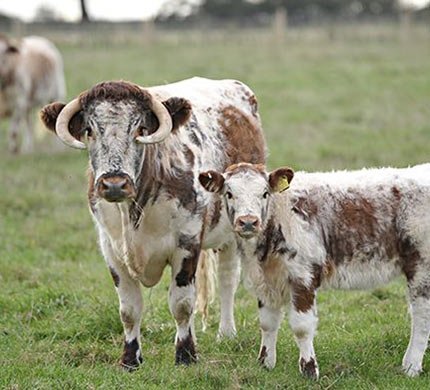English Longhorn
- Temperature:101 to 102.5 degrees F
- Milk:6 to 7 liters per day
- Food:Hay, Pasture grasses
- Pregnancy:280 days
- Nationality:England

General Information
English Longhorn is a breed of cattle that originated in England and is recognized as one of the oldest breeds of cattle in the country. They are a medium-to-large-sized breed with distinctive long, curved horns that can span up to two meters in length. English Longhorns have a variety of coat colors, including red, white, black, and brindle.
English Longhorns are primarily raised for beef production and are known for their flavorful and tender meat. They are also known for their docile temperament and adaptability to a range of environments, making them a popular choice for beef cattle production in many parts of the world.
In addition to their use for beef production, English Longhorns are also used for conservation grazing and as show animals. They are known for their hardiness and ability to thrive on low-quality forage, which makes them well-suited for grazing in conservation areas and other marginal lands.
Where we find this cow to buy?
English Longhorns can be found for sale at various cattle markets, auctions, and livestock shows, as well as through private breeders and farmers. However, since they are a relatively rare breed, it may take some effort to find a breeder who specializes in English Longhorns in your area.
One way to find English Longhorns for sale is to contact breed associations or clubs, such as the English Longhorn Cattle Society in the UK or the American English Longhorn Association in the US. These organizations often have breeder directories and classified ads that can help you find English Longhorns for sale in your area.
Another option is to search online marketplaces for livestock, such as LivestockOfAmerica.com or Cattle-exchange.com, where you can find English Longhorns for sale from breeders across the country. It is important to research the breeder’s reputation and ensure that they follow good animal husbandry practices before purchasing an animal.
It is worth noting that English Longhorns are primarily raised for beef production rather than dairy production, so they may not be as widely available as dairy breeds such as Holstein or Jersey.

How to increase milk production in English Longhorn
English Longhorn cows are primarily raised for beef production rather than milk production, and their milk production is generally lower than that of specialized dairy breeds such as Holstein or Jersey. However, there are some management practices that can help increase milk production in English Longhorns:
01
Cows should be provided with high-quality forage and concentrates, and their diet should be adjusted based on their stage of lactation.
02
Proper milking hygiene is crucial to maintaining udder health and preventing infections, which can negatively affect milk production.
03
Milking cows more frequently can help increase milk production. Ideally, cows should be milked at least twice a day.
04
Selecting cows with high milk production potential and breeding them with high-yielding bulls can improve milk production.
Medicine
There are several types of medicines that may be used for English Longhorns, depending on the health issue that needs to be addressed. Here are some common types of medications used for cattle:
01
AntibioticsAntibiotics may be used to treat bacterial infections such as pneumonia, mastitis, or foot rot.
02
AnthelminticsAnthelmintics are medications used to treat or prevent internal parasites.
03
VaccinesVaccines can help prevent infectious diseases such as bovine viral diarrhea, bovine rhinotracheitis, and leptospirosis.
04
NSAIDsNSAIDs are used to relieve pain and reduce inflammation in cattle with arthritis, lameness, or mastitis.
Pregnancy
The first step in pregnancy is breeding, which involves introducing a bull to the cow during her estrus cycle. The bull will mate with the cow, and if fertilization occurs, pregnancy begins.
As the pregnancy nears its end, the cow will begin to show physical signs of impending calving, such as udder development and a loosening of the pelvic ligaments. When labor begins, the cow will give birth to a calf.
After fertilization, the fertilized egg will travel to the uterus and implant in the lining. Over the next nine months, the fetus will develop and grow inside the cow.
During pregnancy, it is important to monitor the cow’s health and nutrition to ensure the health of both the cow and the developing fetus.
Important!
It is important to work with a veterinarian to ensure proper pregnancy care and to address any health issues that may arise during pregnancy or after calving.
Food
English Longhorns, like all cattle, require a balanced diet that meets their nutritional needs for maintenance, growth, and milk production. Here are some general guidelines for feeding English Longhorns:
English Longhorns are well adapted to grazing on pasture, which should make up the majority of their diet. High-quality forage, such as grass, hay, and silage, provides energy, protein, and fiber.
It is important to balance the diet to meet the specific needs of the cow based on factors such as age, weight, stage of production, and health status. A nutritionist can help develop a balanced feeding program.
In addition to forage, concentrates such as grains, soybean meal, and minerals may be added to the diet to supplement nutrients and energy. However, concentrates should be fed in moderation to avoid digestive issues such as bloat.
During the winter months or when pasture quality is low, additional forage or hay may be required to meet the cow’s nutritional needs. Additionally, in areas where grazing is limited, a TMR or other commercially available feeds may be used to supplement the diet.
Facts
Here are some interesting facts about English Longhorn cattle:
English Longhorns are a British breed of cattle that have been around since the 17th century. They were originally used for meat production but have also been used for milk production and as draught animals.
English Longhorns are a large breed of cattle with distinctive long, curved horns that can span up to 2.4 meters (8 feet) from tip to tip. They have a broad forehead, a wide muzzle, and a large frame.
English Longhorns are known for their docile and gentle temperament, which makes them easy to handle and work with. They are also intelligent and can be trained for a variety of tasks.
Although this are primarily used for beef production, they are also capable of producing high-quality milk with high butterfat content. They are a hardy breed that can thrive in a range of environments.
English Longhorns were once at risk of extinction, but thanks to conservation efforts, their numbers have rebounded. Today, they are still considered a rare breed, but their population is stable and increasing.
English Longhorns have played a significant role in British culture and history, featuring in artwork, literature, and even the Royal Coat of Arms. They are also a popular breed for agricultural shows and fairs.